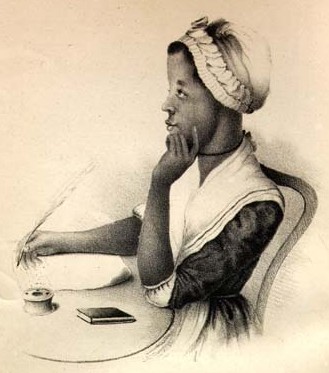
Phillis Wheatley (1753-1784), (wikimedia.org)
Dear Friend,
I have learned many things since stepping into this role of “community advocate.” What I have learned most is the amount I don’t know about what I should have known. Every day I learn something else that humbles me and makes me think about the world I have been exposed to. This week was no different.
The south-side of Chicago is a place where most people fear. Murders and drugs and dilapidated buildings filled with “vagabonds” and “delinquents,” all the bad things people think about seem to live here. This isn’t what I came to know when I lived in the city. Though I was in the north-side living in the Latin neighborhoods of Albany Park and German area Lincoln Square, I would travel to the South-side to visit friends now and then. Honestly, I was surprised. There was a lot of life and beauty that no one on the north-side ever seemed to know about- at least, it never came up in conversation unless it was surrounding the University of Chicago. The surrounding neighborhood of Hyde Park is gorgeous. Stunning! Beautiful brownstones with green lawns and trees in front yards dappled sidewalks when you walk down Dorchester Street or S Stony Island Avenue, or crossing 55th to Cottage Grove, whose very name elicits pictures of charming- well- cottages and groves. I always enjoyed going to Hyde Park, this diamond tucked away in a “scary, and forbidding South-side.”
If you walk a little further into the city, the buildings do get a bit more run down. Abandoned buildings start to become more visible and broken or boarded up windows tarnish the look of what was once great examples of historic Chicago craftsmanship. This is where you find some of the richest history in the city that you never hear of- the history of Black Chicago.
Let’s go back in time to the mid 1700’s. The colonies had still not revolted. Slavery was still the backbone of economy and no one other than European decedents had status in this New World. This is the world Phillis Wheatley was brought to on a slave ship at the age of about 7 years old. She landed in Boston where the Wheatley family enslaved her. Somehow, this little girl charmed her way into an education, the Wheatley’s daughter becoming her first tutor. Phillis was very intelligent and had a way with words and a pen. She was a poet.
In fact, her poetry was acclaimed by George Washington and by King George III. Not that this praise stopped her from being shunned by other prominent white figures of the day, like Thomas Jefferson. (One must wonder if she scorned his advances…) Phillis was taken to London with the Wheatley family where she was able to publish her first book of poetry in 1773, Poems on Various Subjects, Religious and Moral.
She, at 19 years of age, became the first African American poet to be published- and she was female.
Let’s fast forward to 1915. The Great Migration saw 7 million Black Americans leave the south for a better life. This was still not easy, but there was work and promise, something that they were not afforded in the deep south with its history of racism and repression. Phillis Wheatley House was an organization that had homes in various cities that helped women of color that had no where to go. Women who held refuge in one of these homes were safe and were given an education that would help them support themselves in this new world. A three-story brownstone in Washington Park on the Southside of Chicago was purchased exclusively by the black community to become The Phillis Wheatley House of Chicago. This was run by black women, for black women and supported by the black community.
This home has become a beautiful ruin. It’s sad to see such a beautiful place reduced to fallen facade and decay. It just proves that even our most prized memories need preservation so that our stories can be told in following generations. But one community has not given up hope!
I was contacted by an organization-based the south-side of Chicago who want to preserve this historic landmark and for other pieces of black history that have been set for demolition in the area. There have been news media and stories about this property, but no one has stepped up to do anything to speak up for this iconic home. When I reached out to some of my friends in the local press (white people), their response was “ Can’t that money be better spent elsewhere?“
It is not up to any of us to decide the value of another person’s story. Frankly, it’s none of our business. I would argue that it cost less money to do $1 million renovation on historic property that actually has meaning and value to a community that has been under-served and underappreciated for centuries then it would be to build a brand new museum at twice the price with no history. This community is only asking for the chance to preserve it and other homes like the Phillis Wheatley house. Who are we to deny them that opportunity?
Real estate is people. Investing in people
Is how we will change the world. Let’s live in a world we love by design, not default. Let’s be better.
Together.
Your Fan,
Jacob Reide

